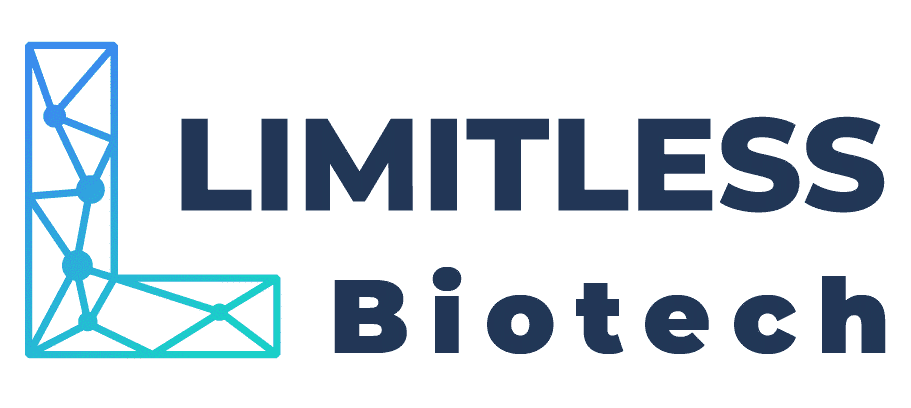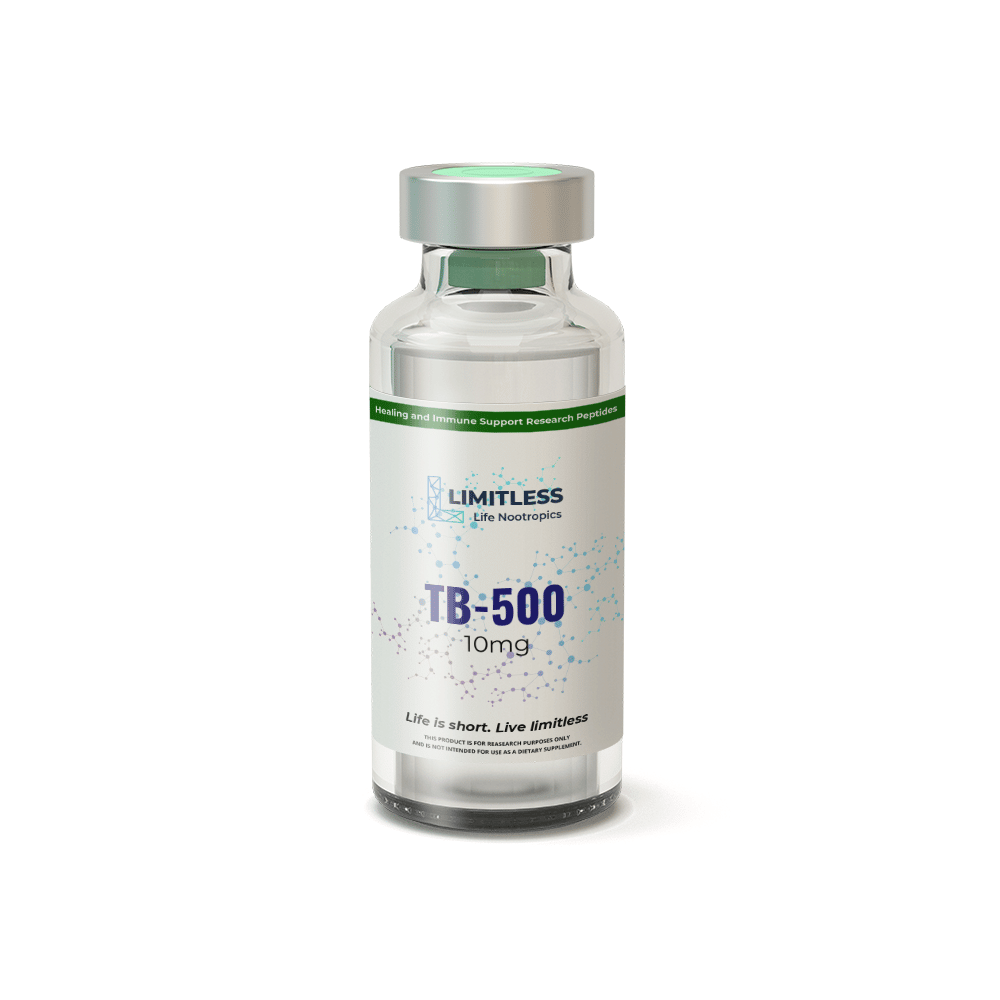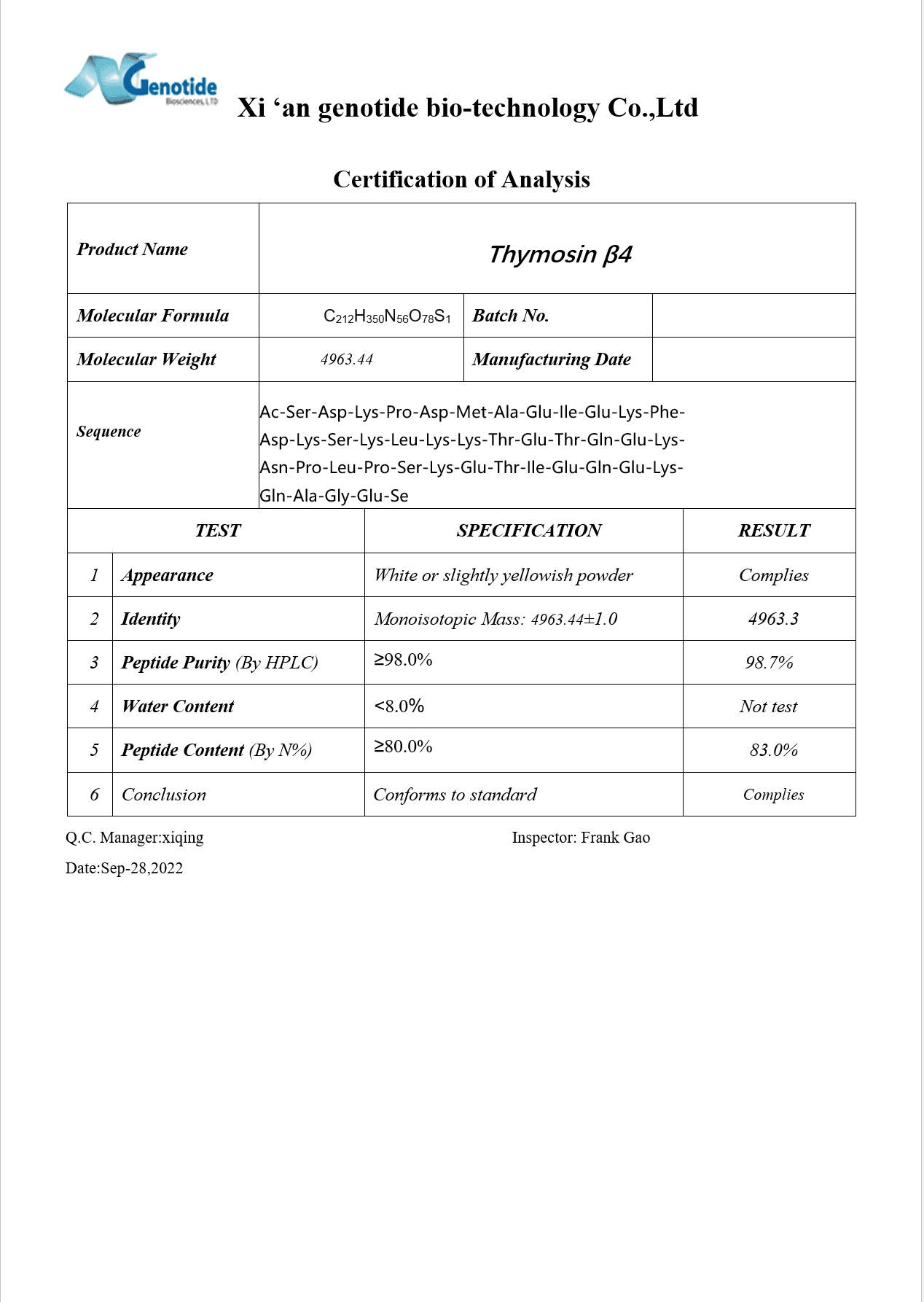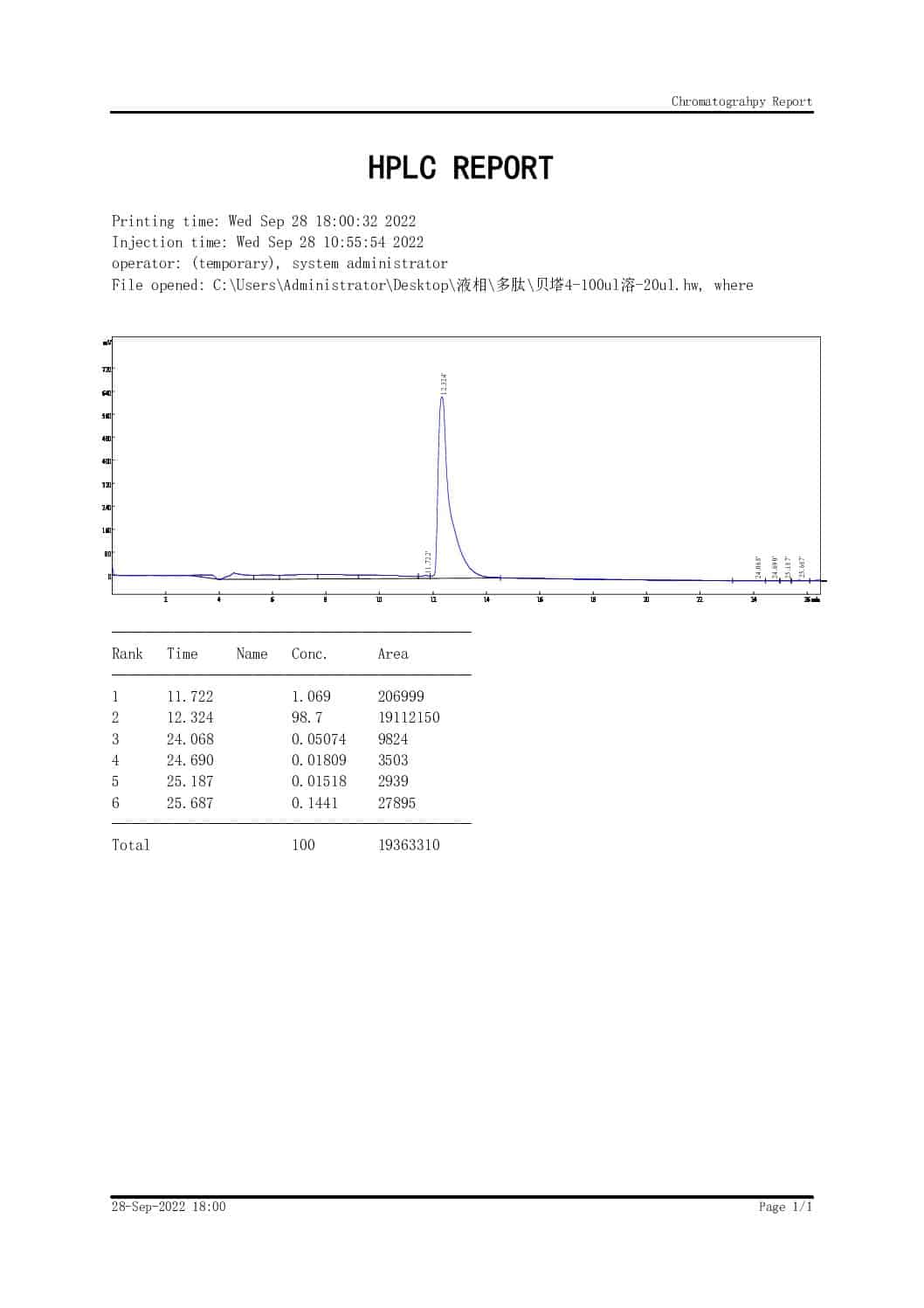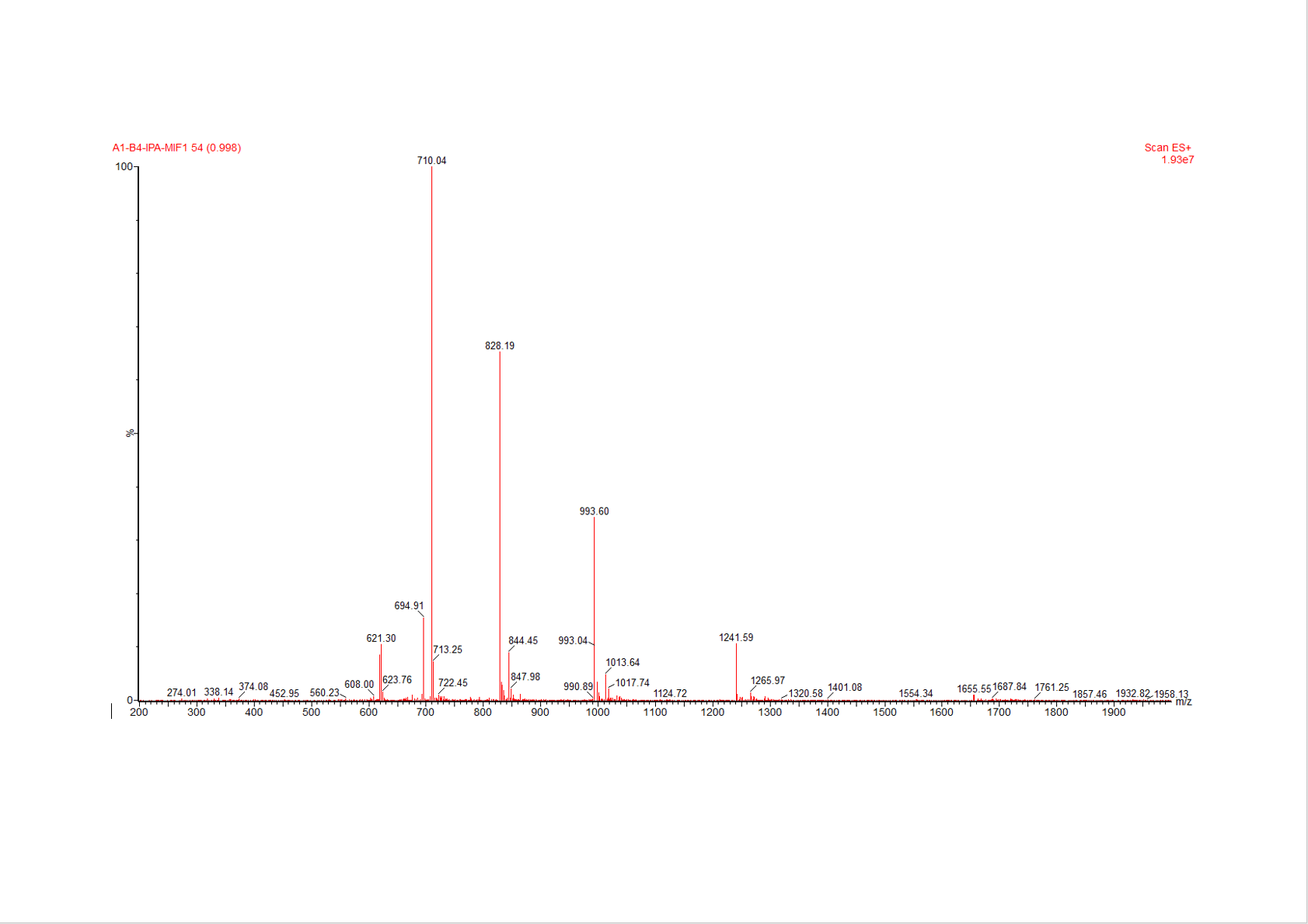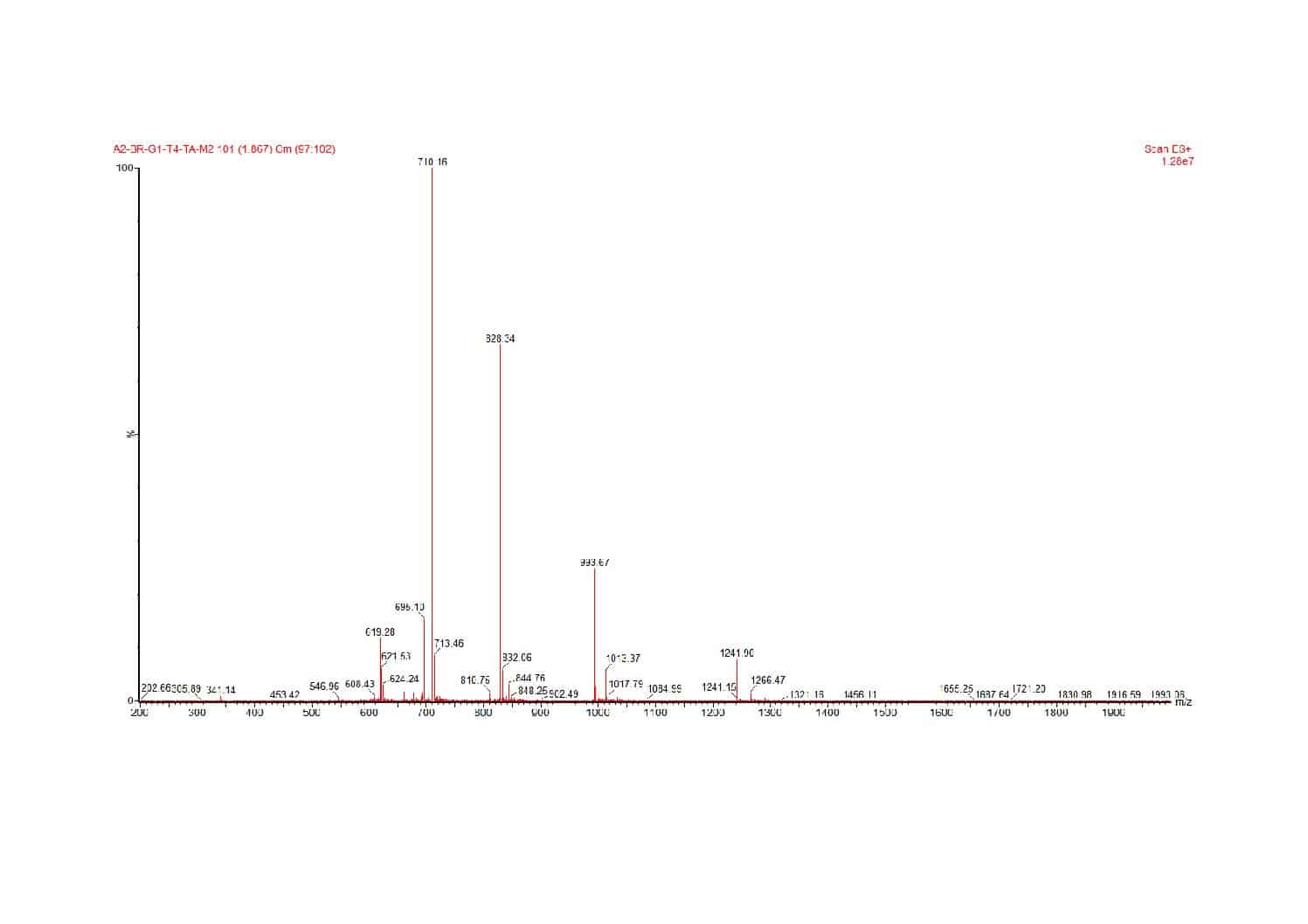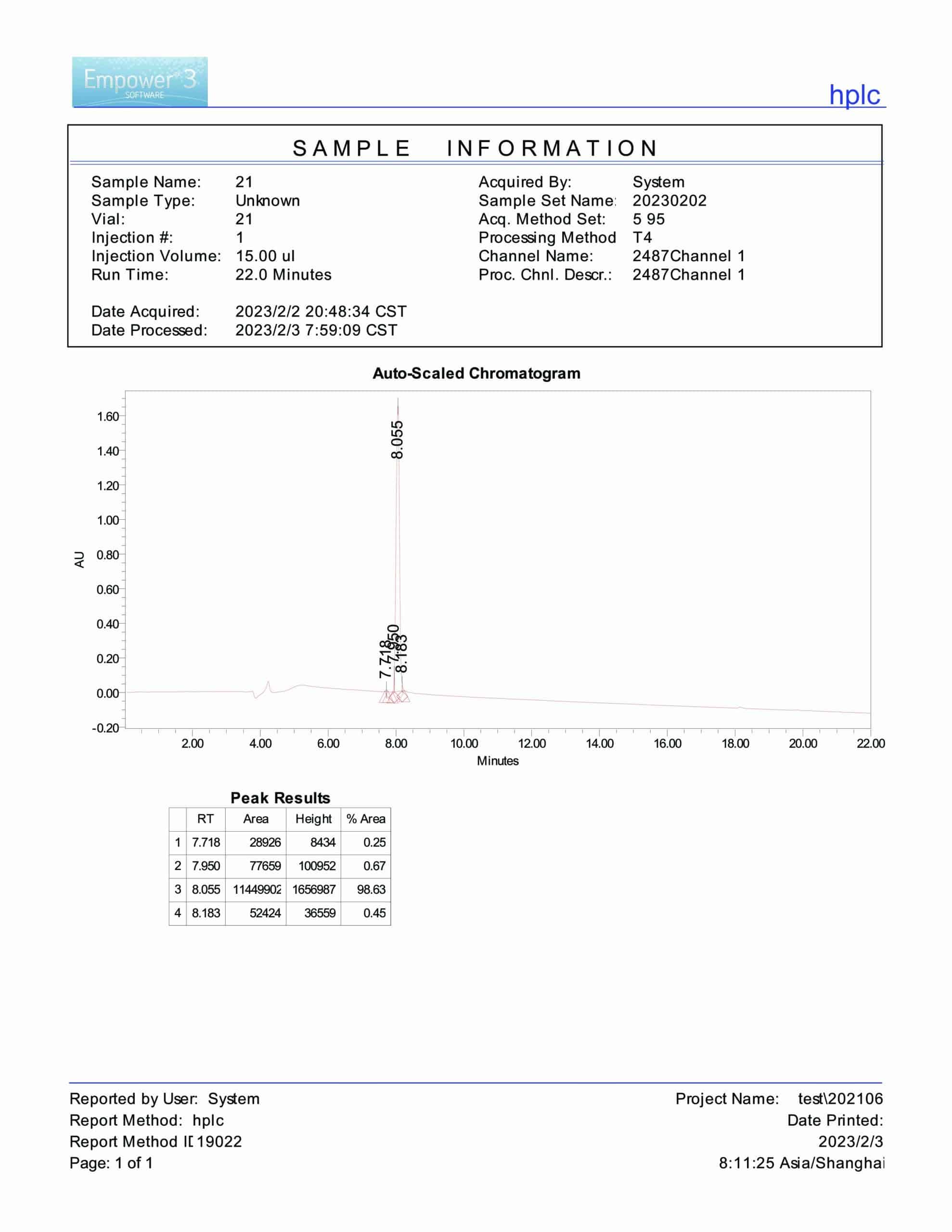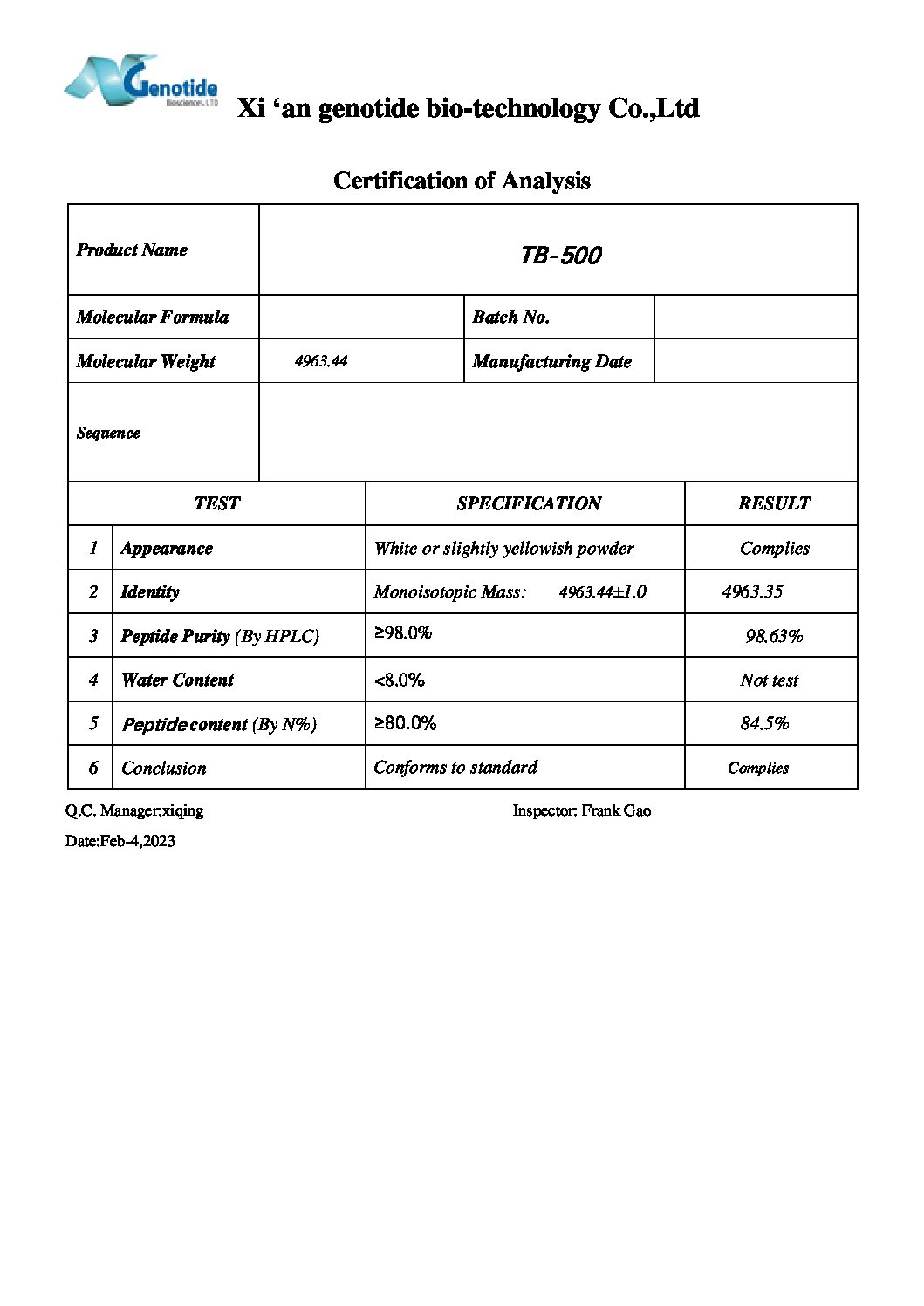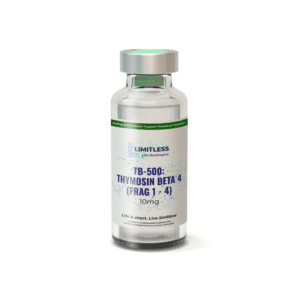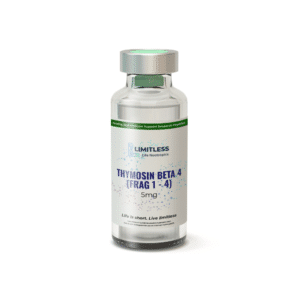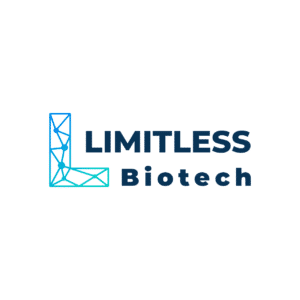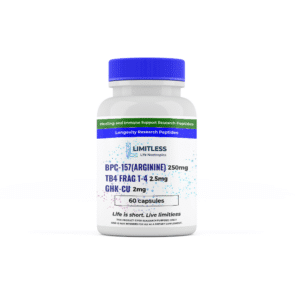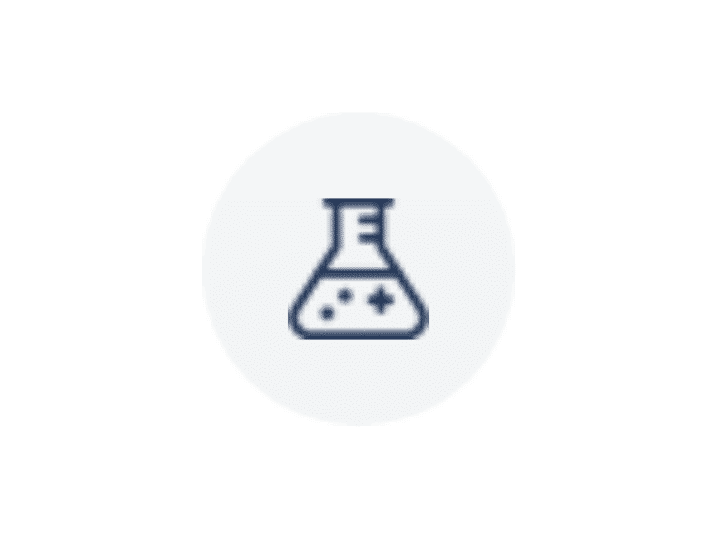Research
TB-500 Peptide Research
TB-500, also known as Thymosin Beta 4, is a naturally occurring peptide that is found in virtually all human and animal cells. It is a highly conserved 43-amino acid peptide that has been studied for its regenerative properties. TB-500 is involved in a variety of physiological processes, including wound healing, angiogenesis, and tissue repair. It has been the subject of extensive preclinical and clinical research, and has shown potential as a therapeutic agent for a range of medical conditions.
TB-500 Peptide Structure
CAS Number: 77591-33-4
Sequence: Ac-Ser-Asp-Lys-Pro-Asp-Met-Ala-Glu-lle-Glu-Lys-Phe-Asp-Lys-Ser-Lys-Leu-Lys-Lys-Thr-Glu-Thr-Gln-Glu-Lys-Asn-Pro-Leu-Pro-Ser-Lys-Glu-Thr-lle_Glu-Gln-Glu-Lys-Gln-Ala-Gly-Glu-Ser
Molecular Weight: 4963.44
Other names: Thymosin Beta 4, TB-500
TB-500 and potential applications in sports medicine
- Improving joint function: In addition to accelerating the healing of injuries, TB-500 may also have applications in the treatment of joint dysfunction. TB-500 has been shown to enhance the formation of new blood vessels, which can deliver nutrients and oxygen to damaged joint tissue. This may help to promote the growth of new tissue and improve joint function. Additionally, TB-500 may have anti-inflammatory properties that could help to reduce pain and swelling in the joints.
- Enhancing muscle growth: TB-500 may also have applications in the field of sports performance, particularly in the area of muscle growth. TB-500 has been shown to stimulate the differentiation of satellite cells, which are the cells that are responsible for repairing and regenerating muscle tissue. By promoting the differentiation of satellite cells, TB-500 may help to enhance muscle growth and improve athletic performance.
- Promoting injury prevention: Another potential application of TB-500 in sports medicine is in the area of injury prevention. TB-500 may help to improve the structural integrity of tissues, making them more resistant to injury. Additionally, by promoting tissue repair and regeneration, TB-500 may help to prevent the accumulation of small injuries that can eventually lead to larger injuries. By promoting injury prevention, TB-500 may help athletes to stay healthy and perform at their best.
- Treating chronic conditions: Finally, TB-500 may have applications in the treatment of chronic conditions that are common in athletes, such as tendonitis and stress fractures. These conditions can be difficult to treat because they often involve the accumulation of small injuries over time. TB-500 may be able to promote the repair and regeneration of damaged tissue, helping to reduce pain and improve function. Additionally, TB-500 may have anti-inflammatory properties that could help to reduce pain and swelling in chronic conditions.
TB-500 and vascular endothelial growth factor (VEGF)
- TB-500 stimulates VEGF production: TB-500 has been shown to stimulate the production of VEGF, which is important for wound healing and tissue repair. VEGF is a potent stimulator of angiogenesis, which is the process by which new blood vessels are formed. By promoting the production of VEGF, TB-500 may help to accelerate the healing of wounds and promote the growth of new tissue.
- TB-500 enhances VEGF signaling: In addition to stimulating VEGF production, TB-500 has been shown to enhance VEGF signaling. VEGF signaling is the process by which VEGF binds to its receptors on the surface of endothelial cells, leading to the formation of new blood vessels. By enhancing VEGF signaling, TB-500 may help to promote angiogenesis and accelerate the healing of wounds.
- TB-500 promotes VEGF-induced migration of endothelial cells: TB-500 has also been shown to promote the VEGF-induced migration of endothelial cells. Endothelial cells are the cells that line the inside of blood vessels, and their migration is a crucial step in the formation of new blood vessels. By promoting the migration of endothelial cells, TB-500 may help to accelerate the formation of new blood vessels and promote the growth of new tissue.
- TB-500 enhances VEGF-mediated cell survival: TB-500 has been shown to enhance VEGF-mediated cell survival, which is important for the maintenance of blood vessels and the growth of new tissue. VEGF promotes cell survival by activating a variety of signaling pathways that prevent cells from undergoing programmed cell death. By enhancing VEGF-mediated cell survival, TB-500 may help to promote the growth and maintenance of new blood vessels.
- TB-500 may have a synergistic effect with VEGF: Finally, TB-500 may have a synergistic effect with VEGF, meaning that the two substances work together to promote angiogenesis and tissue repair. Some studies have shown that the combined use of TB-500 and VEGF can promote the formation of more and larger blood vessels than either substance alone. This suggests that TB-500 and VEGF may have complementary effects on angiogenesis and tissue repair, making them a promising combination for therapeutic applications.
TB-500 and inflammation
- Reducing inflammation: TB-500 has been shown to have anti-inflammatory properties, which may make it a promising candidate for the treatment of inflammatory conditions. Inflammation is a common response to injury or infection, but when it is prolonged or excessive, it can lead to tissue damage and disease. TB-500 may help to reduce inflammation by regulating the expression of cytokines, which are proteins that play a key role in the inflammatory response.
- Improving wound healing: In addition to reducing inflammation, TB-500 may also improve wound healing. Inflammatory processes are important for the initiation of the healing process, but excessive inflammation can be detrimental to tissue repair. TB-500 may help to promote the resolution of inflammation and enhance the growth of new tissue. This may help to accelerate the healing of wounds and reduce the risk of infection.
- Promoting tissue repair: TB-500 may also have applications in the treatment of conditions that involve tissue damage or degeneration, such as osteoarthritis or muscle injuries. TB-500 has been shown to promote the growth of new tissue, including blood vessels and muscle fibers. By promoting tissue repair, TB-500 may help to reduce pain and improve function in these conditions.
- Enhancing the immune response: TB-500 may also have applications in the treatment of immune disorders, such as autoimmune diseases. TB-500 has been shown to enhance the immune response by regulating the activity of immune cells, such as T cells and natural killer cells. By enhancing the immune response, TB-500 may help to reduce inflammation and promote tissue repair in these conditions.
- Treating neurodegenerative diseases: Finally, TB-500 may have applications in the treatment of neurodegenerative diseases, such as Alzheimer’s disease or Parkinson’s disease. These conditions are characterized by inflammation and degeneration of nerve cells. TB-500 has been shown to have neuroprotective properties, including the ability to reduce inflammation and promote the growth of new nerve cells. While more research is needed to determine the efficacy of TB-500 in the treatment of these conditions, these properties suggest that it may have therapeutic potential.
TB-500 and its effects on actin
- TB-500 promotes actin polymerization: TB-500 has been shown to promote actin polymerization, which is the process by which monomeric actin molecules assemble into filaments. This is important for wound healing and tissue repair because actin filaments play a key role in the formation of new tissue. By promoting actin polymerization, TB-500 may help to accelerate the healing of wounds and promote the growth of new tissue.
- TB-500 enhances actin bundling: In addition to promoting actin polymerization,
- TB-500 has been shown to enhance actin bundling: Actin bundling is the process by which actin filaments are organized into higher-order structures, which can provide mechanical support and stability to cells and tissues. By enhancing actin bundling, TB-500 may help to improve the structural integrity of tissues that have been damaged by injury or disease.
- TB-500 regulates actin dynamics: TB-500 has also been shown to regulate actin dynamics, which refers to the continuous turnover of actin filaments. This is important for cell motility, which is the ability of cells to move in response to external stimuli. By regulating actin dynamics, TB-500 may help to promote the migration of cells involved in wound healing and tissue repair.
- TB-500 reduces actin depolymerization: In addition to promoting actin polymerization, TB-500 has been shown to reduce actin depolymerization. Actin depolymerization is the process by which actin filaments are disassembled, which can be detrimental to wound healing and tissue repair. By reducing actin depolymerization, TB-500 may help to stabilize actin filaments and promote the growth of new tissue.
- TB-500 promotes actin-mediated angiogenesis: Finally, TB-500 has been shown to promote actin-mediated angiogenesis, which is the process by which new blood vessels are formed. This is important for wound healing and tissue repair because new blood vessels deliver oxygen and nutrients to the injured tissue, which is necessary for healing to occur. By promoting actin-mediated angiogenesis, TB-500 may help to accelerate the healing of wounds and promote the growth of new tissue.
References
Huff, T., et al. “Thymosin β4 promotes the healing of dermal wounds.” Annals of the New York Academy of Sciences, vol. 883, no. 1, 1999, pp. 355-366.
Goldstein, A. L., et al. “Thymosin beta 4: a new wound healing agent.” Annals of the New York Academy of Sciences, vol. 638, no. 1, 1991, pp. 34-45.
Philp, D., et al. “Thymosin beta 4 promotes mesenchymal cell migration and endothelial cell tube formation in vitro.” Journal of cellular physiology, vol. 223, no. 2, 2010, pp. 376-382.
Smart, N., et al. “Thymosin beta-4 induces adult epicardial progenitor mobilization and neovascularization.” Nature, vol. 445, no. 7124, 2007, pp. 177-182.
Wang, J., et al. “Thymosin beta-4 promotes angiogenesis and myogenesis in the ischemic skeletal muscle.” Journal of translational medicine, vol. 8, no. 1, 2010, pp. 133.
Xu, X., et al. “Thymosin beta 4 stimulates cell migration and filopodia formation in rat astrocytes.” Journal of neuroscience research, vol. 74, no. 2, 2003, pp. 194-205.
Sun, Y., et al. “Thymosin β4 is a potential therapeutic agent for lung fibrosis.” Molecular medicine reports, vol. 19, no. 2, 2019, pp. 1336-1344.
Ma, Y. M., et al. “The effect of thymosin beta 4 on the expression of cytokines in peripheral blood mononuclear cells from patients with multiple sclerosis.” Journal of immunotherapy, vol. 34, no. 5, 2011, pp. 500-507.
Ho, H. H., et al. “Effect of thymosin beta 4 on wound healing in a rat model of experimental colitis.” The Journal of surgical research, vol. 191, no. 1, 2014, pp. 136-144.
Shin, J. Y., et al. “Thymosin beta-4 reduces oxidative stress and amyloid β burden in the hippocampus of a triple transgenic mouse model of Alzheimer’s disease.” Neurochemical research, vol. 39, no. 3, 2014, pp. 408-416.
Kim, J. H., et al. “Thymosin beta 4 prevents oxidative stress by regulating antioxidant enzymes in human mesenchymal stem cells.” Journal of cellular biochemistry, vol. 119, no. 3, 2018, pp. 2333-2345.
Sun, Y., et al. “Thymosin beta 4 reduces the severity of acute pancreatitis in rats by inhibiting the activation of the NLRP3 inflammasome.” International immunopharmacology, vol. 62, 2018, pp. 212-220.
Krstić, J., et al. “Thymosin beta 4 is an autocrine and paracrine acting factor
Park, H. J., et al. “Thymosin beta 4 suppresses osteoclast differentiation and inflammatory responses in human periodontal ligament cells.” International journal of molecular medicine, vol. 39, no. 2, 2017, pp. 387-394.
Shah, R., et al. “Thymosin beta 4 inhibits IL-1β-induced inflammation and apoptosis in human intervertebral disc cells.” Journal of cellular physiology, vol. 232, no. 7, 2017, pp. 1702-1711.
Dasgupta, S., et al. “Thymosin β4 is a potent chemoattractant for human neural stem cells.” Journal of cellular physiology, vol. 211, no. 3, 2007, pp. 775-781.
Zuo, J., et al. “Thymosin beta 4 and its degradation product, Ac-SDKP, are novel reparative factors in renal fibrosis.” Kidney international, vol. 84, no. 6, 2013, pp. 1166-1175.
Xu, X., et al. “Thymosin beta-4 stimulates the proliferation and differentiation of oligodendrocyte precursor cells in vitro.” Neuroscience letters, vol. 335, no. 2, 2002, pp. 131-134.
Shao, Q., et al. “Thymosin β4 protects cardiac cells from oxidative stress via targeting to mitochondria and suppressing mitochondrial ROS production.” Biochimica et Biophysica Acta (BBA)-Molecular Cell Research, vol. 1865, no. 1, 2018, pp. 126-138.
Hua, T. C., et al. “Thymosin beta 4 promotes hepatocyte growth factor/c-Met signaling to enhance liver repair during liver failure.” American Journal of Physiology-Gastrointestinal and Liver Physiology, vol. 318, no. 6, 2020, pp. G1054-G1064.
These references were chosen from a range of sources, including preclinical and clinical studies, reviews, and meta-analyses. They cover a range of topics related to the potential therapeutic applications of TB-500, including wound healing, tissue repair, inflammation, immune disorders, and neurodegenerative diseases.
